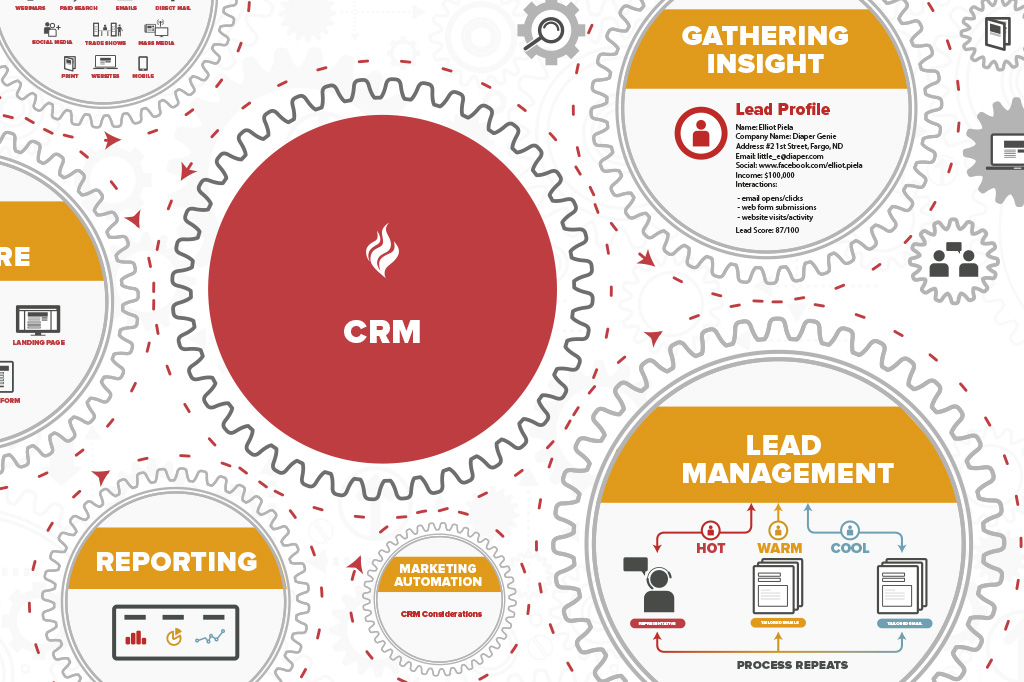
That’s right folks, yet another acronym. But for business owners, sales reps, and marketers, it’s definitely one to remember. An 18 billion dollar industry, CRM (Customer Relationship Management) systems have revolutionized the way companies sell, market, and provide service. Big data, baby.
And more than likely, your competitors are leveraging CRM to reduce costs and increase profitability by streamlining the customer experience. How? By bringing together information from all data sources within an organization (and outside, when applicable) to give a single, holistic view of each customer and prospect in real time, of course!
Close your eyes. Now imagine sales, marketing, and customer service departments making quick yet informed decisions on everything from their sales pipeline (new business forecasting and existing business like cross-selling and up-selling opportunities) to target marketing strategies and competitive positioning tactics. I know, right? Gives you one of those dumbfounded Keanu Reeves’ “whoa” moments.
However, deciding to make the CRM leap shouldn’t be a decision that comes without scrutiny. And let’s get one thing clear—simply purchasing a CRM solution isn’t a guaranteed silver bullet. There are three key elements to a successful CRM initiative: people, process, and technology. And from my experience, knowing if and when a company is ready to align these three elements is often a daunting decision.
Whether you’re a tenured CRM vet or just finally learned what CRM stands for, the essentials are always key. Here are a few of the most common organizational pitfalls (don’t fret, you’re not alone) and how CRM can alleviate these problems:
1. Disparate Data
Without CRM, prospect and customer data is often scattered across the business. All over the place. Data stored in business cards, post-it notes, emails, documents, spreadsheets, databases, financial software, and of course my favorite, in peoples’ heads. Sound familiar? Now, for some small companies this approach will suffice, but with business growth, the information becomes exponentially “silo-ed,” resulting in potential missed revenue opportunities and costly inefficiencies.
By consolidating these silos, CRM transforms disparate data into meaningful information that’s made accessible organization-wide and, if necessary, remotely for staff working from home or on the road:
- Marketers can create and measure more relevant, targeted campaigns.
- Sales teams can engage in more meaningful and lucrative conversations.
- Executives can make more informed strategic business decisions.
2. Lack of Sales Process and Insight
With CRM absent, evaluating sales pipeline data can be a complicated and often futile exercise – usually involving a cumbersome and manual spreadsheet exercise (you just grumbled and shook your head, didn’t you?).
The inability to accurately forecast revenue debilitates sales management reporting and leadership direction. I mean, who doesn’t love predicting Q3 revenue based on a sales rep’s gut instinct? CRM applications can help your sales team organize, automate, and synchronize business processes to help you find, attract, and win new clients in addition to retaining those you already have.
Of course, we must remember CRM software is just technology. It only works as well as the people and processes allow it to. Defining a lead management process and having it adopted by your sales team is the most imperative part in CRM sales success. Providing a centralized, web-based, intuitive CRM system where salespeople can maintain their pipeline of sales opportunities is a catalyst for such success.
3. Marketing Alone in Left Field
Oh, so lonely. More often than not, marketing is busy creating and executing lead generation campaigns – isolated from the wonderland of rich customer data. Sales want more leads! However, once generated, those leads are often not distributed quickly enough, and when they are, sales teams don’t always find them to be “qualified.” The marketing department receives no metrics as to which campaigns are most effective, making it almost impossible to justify budget spend.
Conversely, CRM systems integrate marketing functions into the sales department’s operations. New leads are generated and fed into a CRM system – the lead management process kicks in. A lead is scored to determine if it’s qualified and ready for sales follow-up or if the lead is just at the beginning of the sales cycle, requiring nurture marketing to develop latent demand. Once sales-ready, CRM automatically assigns the lead to the right salesperson.
Since the progress of leads can be followed through the entire marketing and sales process, the marketing department is able to measure which campaigns are the most effective ones (i.e. cost per lead, cost per sale, etc.), better focus its future efforts, and justify marketing spend.
If you find CRM both fascinating and a bit intimidating, please join us at the Marketing Technology Summit. Local marketing technologists, professors, and professionals are getting together July 23rd (Fargo) and July 24th (Duluth) during this free half-day event to explore how businesses of all types are using integrated tools like CRM and Marketing Automation to streamline business processes; build, track, and analyze their efforts; and drive revenue growth by closely aligning both sales and marketing departments. Hope you’ll join us! #MARTECH2013
